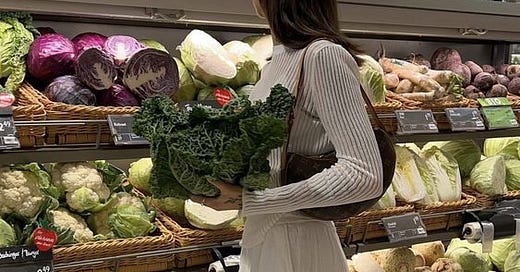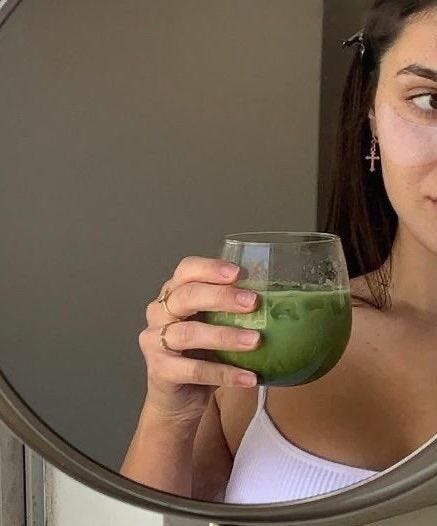Health Foods, as we know them today, are a complete scam.
They are expensive, taste weird, and most of the time, not even healthy.
But they are cause even more harm than the mere waste of money—they also keep everyone else from improving their health.
How? Join me for a journey through diet psychology and cultural complacency that you haven’t heard anyone else talk about.
A tiny slice of a huge pie
The Health Food market is $20B annually in the US.
First, it’s important to understand the size of the health food market in context of the broader food market.
$20B might sound like a lot. It is, until you recognize how big the entire food market is— One trillion dollars in 2023.
Overall, the health food market accounts for a mere 2% slice of the overall food industry.
This should conform with your personal experience as well— for every person like you who is interested in healthy food, there are about 49 others who don’t care about good food one bit.
Sad, but relatable.
But this makes you wonder—why the disparity?
Why are we Tan Landians, and our brothers and sisters in similar health-inclined digital city-states, such a tiny minority?
Health Foods taste bad
“Why aren’t you on <x diet>?”
The health-obsessed invariably ask everyone around them.
The typical response?
“I’d rather just enjoy my life than be healthy all the time.”
Simply put, everyone thinks that health foods taste bad. The idea is ingrained in us from birth at every possible opportunity in the West.
In middle school health class, you learn that health foods are whole grain bread (tastes like cardboard) and brocolli, while Doritos and McDonald’s taste amazing when you get to eat them after your little league games each weekend.
At the doctors office as an adult, you must suffer through lectures about the dangers of high-cholesterol bacon and eggs, and internalize recommendations to eat celery and “heart healthy” flax seeds instead.
And at every cultural interaction we have involving food, there is always the implicit tradeoff between health and taste, and feelings of guilt one way or the other.

The language of guilt
When we choose taste, we “know” that it’s bad for us, and have to qualify our decisions in an appeal to “fairness” of some kind.
The things we tell ourselves about food are inextricably bundled up with feelings of guilt around our sense of willpower:
Want to get wings and watch the Superbowl? It only comes once a year.
Want to eat a pint of Ben and Jerries? It was a tough week at work, I’m splurging.
Chips and guac on the weekend? I worked out this week, I earned it.
The converse is also true. When we feel bad about our self-discipline, we punish ourselves with Health Foods:
I was sooo bad during the holidays, I’m going on a strict diet in January.
It’s summer soon and I want to look good at the beach, I can only eat green juices and chicken breast.
I ate way too much this weekend, I’m intermittent fasting for the rest of the week.
Psychological misery
This cycle of binging, guilt, and heightened self-discipline is a psychological cycle that is completely unproductive.
It never leads to a steady state of happiness or fulfillment, and guarantees that bad feelings will always be at the forefront of your thoughts around food.
You’re binging, so you feel guilty
You feel guilt, and that feels bad (self-doubt, low self-esteem)
You’re self-disciplining, which is painful and miserable
None of this is to say that self-discipline and self-improvement are a problem in general.
But in this context, they are unproductive because there is no path to overcoming these feelings. The same cycle, over and over, forever.
A minority of people
This is likely a very familiar experience for you as someone who is interested in health.
But most everyday people recognize this, either implicitly or explicitly, and choose to opt out.
When they say “I’d rather enjoy my life than be healthy all the time”, this is exactly what they mean.
The thing is, they’re right.
The point of eating is not to be miserable all the time. Misery does not lead to health.
At the same time, neither does the junk food they complacently eat.
They’re not happy either— but at least they have the comfort of blaming “external” forces for their unhappiness.
Does that mean health is a bad goal to have, and we should just give up?
Of course not. But long time readers will know that there is a third, under-appreciated option, that satisfies the demands of both sides.
And it’s not health food.
Health Foods aren’t healthy
To make this situation easier to understand, it’s important to realize how unhealthy most “health foods” are.
Depending on whom you ask, the following are considered healthy:
“Heart healthy” vegetable oils
Gluten free bread
Tofu and soy milk
[I’ve written about many of the harms of these “health foods” in the links above if you want to learn more.]
Yet readers of Tan Land will note that most of the things branded as “health foods” are far from it.
Things like pasture raised meat, eggs, dairy, fruit, honey, and real bread are actually healthy.
But none of these are labeled as Health Foods.
You can start to see how Junk Food vs. Health Food is really just Junk Food vs. Other Junk Food.
And this, ladies and gentlemen, is where the true danger of Health Foods lies…
Junk food vs. health food
The above listed truly healthy foods are not considered “Health Foods.”
But neither are they considered “junk food.”
They exist in this indefinite middle category, while most people bifurcate the world of food into health vs. junk food.
For the 2% of people in the “Health Food” camp, this is a problem. It distracts and co-opts their efforts at self-improvement into foods that still make Big Food companies more money, and wastes their health.
It’s a sad trap that the minority of high-will-power, self-disciplining individuals will find themselves in, potentially for many years, before truly leaving the Cave of Food Lies.
But fortunately, they’ll find their way to the raw milk and meat (i.e., real food) camp eventually.
Stuck in junk world
However, for the 98% of people in the junk food camp (i.e., all normal people), this is a massive catastrophe.
Because “health foods” taste horrible in the popular imagination, people who are not inclined toward health will never find it, because they write off the entire category as miserable.
Do sick people like being sick? Of course not.
But they dislike the prospect of eating cardboard and kale even more.
And so they don’t— they remain complacent with their Doritos and chicken nuggies, meanwhile if they sought the real healthy foods which don’t taste bad, they would be able to have their cake and eat it too.
Healthy living will never succeed so long as normal people remain convinced that health is miserable.
This is a huge marketing problem that us health folks have found ourselves in.
I quit my job to help make the world a healthier place. Please consider becoming a paid subscriber of Tan Land to support my work and to gain access to my full archive of articles designed to help you live a healthier, more enjoyable life.
We need everyone to be healthy for us to be healthy, and so solving this problem informs all of my efforts at health propaganda across my various channels, and of course through MASA Chips.
If you ever have the chance to promote a healthy lifestyle, whether to your friends, family, or online, I exhort you to make sure this idea underlies all of your rhetorical efforts.
Summary
“Health Foods” are a small piece of the huge food market
It’s not because health itself is unappealing, but that the “health foods” themselves are generally unappealing and few people like bad tasting food
Even worse, Health Foods themselves usually aren’t healthy, and therefore the few people who buy them waste their efforts and money
Health Foods are the most dangerous to the people who are not interested in health at all, because the un-appealing alternative keeps them complacent with a diet of junk food
The only way to solve this conundrum is to ruthlessly demonize unhealthy Health Foods, and promote real healthy foods that of course actually taste good.





